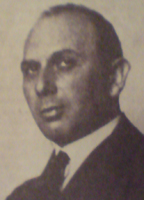Oskar Herman
| Oskar Herman | |
|---|---|
 |
|
| Born |
17 March 1886 Zagreb, Austro-Hungarian Monarchy, (now Croatia) |
| Died | 22 January 1974 (aged 87) Zagreb, SFR Yugoslavia |
| Nationality | Croatian |
| Education | Zagreb, Munich |
| Known for | painting |
| Notable work | paintings in oils and watercolour, drawings |
| Movement | colourist expressionism, modern |
Oskar Herman (1886–1974) was a Croatian Jewish painter. He was one of the group of Croatian artists known as the Munich Circle, who had a strong influence on modern art in Croatia.
Herman was born on 17 March 1886 in Zagreb to Croatian Jewish family of Danijel and Jozefina Herman. His father died when he was 4 years old. He initially attended business school in Zagreb, although his interest was in drawing and painting. He studied art at the painting school of K. Filip in Zagreb. Then he moved to Munich where in 1904, like his compatriot Josip Račić, he attended the school of the Slovene painter and teacher Anton Ažbe. In 1905 he enrolled in the Academy of Fine Arts in Munich, where he studied until 1910 under teachers such as Hugo von Habermann. At that time Munich was a center of European art scene for Realism, Post-Impressionism, Symbolism and Jugendstil.
In 1914, after the start of World War I, Herman returned to Zagreb. Being partially unfit for military service, he served the army in Zagreb, from 1915 to 1918. He then went to Munich again, where he continued to live until 1933, with short stays in Zagreb, Berlin and Paris. At that point, due to the escalation of Nazism, he returned to Zagreb. During his stay in Munich he regularly displayed his work, with some success, at solo shows as well as participating in exhibitions of Munich Secession Art.
In the war years, Herman joined Partisan forces and was captured and confined in the refugee camp (1942–44) of Ferramonti di Tarsia, in Calabria, southern Italy. After his release he joined the artists colony of Cozzano.
...
Wikipedia
